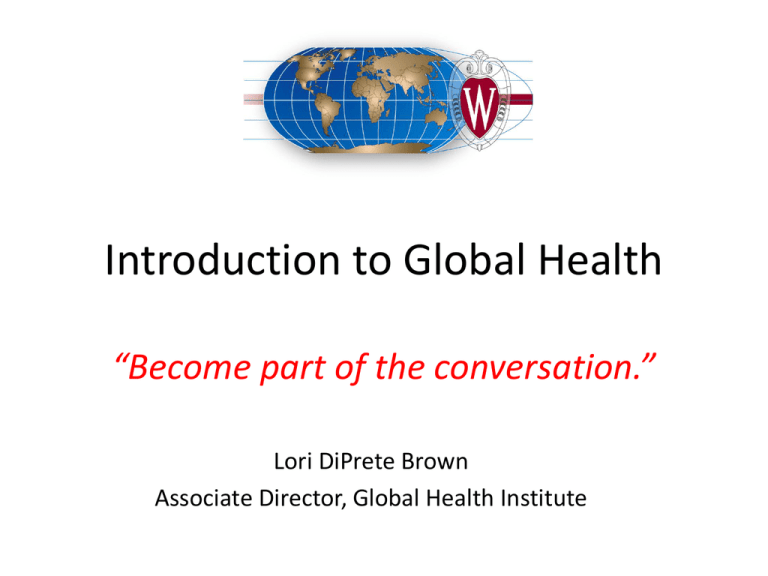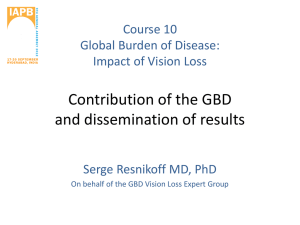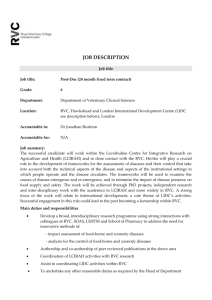
Lecture 1.2
I
Introduction to Global Health
“Become part of the conversation.”
Lori DiPrete Brown
Associate Director, Global Health Institute
Objectives
Provide an overview of teaching resources on:
•
•
•
•
•
Definition of Global Health and GH Successes
Current GH Trends and Challenges
Global Health Timeline
The MDGs and the Post 2015 Agenda
How to Find and Use and Communicate GH
Information
• First Do No Harm…
Why Should we Care about Global
Health?
•
•
•
•
•
National Security
Trade economic productivity
Inequalities are unethical and unjust
States have humanitarian responsibilities to other states
Are we separate countries, or an interconnected world?
• “Global health, like global climate change, may soon become
a matter so important to the world’s future that it demands
international attention, and no state can escape the
responsibility to act.” -- Gostin
Have Global Health Efforts been
Successful? Just say YES!
•
•
•
•
•
•
•
•
•
•
Small pox eradication 1979
Vitamin A supplementation in Nepal prevents 200,000 child deaths
Polio eliminated from western hemisphere 1991
Reduction of infant death due to diarrhea by 82% from 1982 to
1987 in Egypt
Dramatic reduction in Guinea Worm –reduced by 99% in 20
countries
Fertility reduction in Bangladesh from 7 to 3 children per woman
Overall improvements in IMR 126 to 56/1000, CMR 197 to 82/1000,
from 1960 to 2002.
Under 5 child mortality decreased by 60% from 1990 thru 2010
Between 1990 and 2010, life expectancy increased by 12-15 years
for men and women
Burden due to HIV and Malaria is falling
Successful Programs in Action
Bangladesh Rural Advancement Committee (BRAC)
http://www.youtube.com/watch?v=5s0yVZlFdMU
Meningitis Vaccine for Africa
http://www.youtube.com/watch?v=tZMiYTZpQUQ
For other success stories see RX for Survival Series
http://www.pbs.org/wgbh/rxforsurvival/series/vide
o/index.html
Is Global Health Engagement
Optional or a Human Rights Imperative?
A Preferential Option for the Poor
“Although PIH is a secular organization not affiliated with,
motivated by, or espousing any particular religious ideology, we
find the concept of “a preferential option for the poor” to be a
powerful moral imperative. The “poor” includes but is not limited
to those who are economically deprived. The concept of “a
preferential option for the poor” challenges us to be advocates for
the voiceless and powerless among us. Those who are in any way
and for any reason deprived, marginalized, or vulnerable have a
special moral claim on the community. As a matter of both justice
and charity, we must put in place structures and systems to
address and meet their needs, so that they might participate
more fully in the common good and thereby flourish more fully as
human persons.”
–Partners in Health
….for all of us, when we are vulnerable to harm?
What is Global Health?
Image Courtesy of: lidc.org.uk
What is Global Health?
Health care, but not “just” health care
NOT just the absence of disease
NOT limited to sites outside the US
Linked to terms international health, global
public health, public health, sustainable
health
Draws on many disciplines
Grounded in social justice philosophy
Includes HEALTH IN ALL POLICIES multisector efforts to improve well-being that use
prevention as prime intervention strategy
Linked to government, bilateral and multilateral cooperation, NGOs, civil society and
the private sector.
Global Health is Public Health for the World!
Global Health Scope, Trends and
Challenges
Image Courtesy of: lidc.org.uk
The Scope of Global Health
•
•
•
•
•
•
Communicable
Disease
Non-Communicable
Disease
Nutrition and Food
Systems
Unintentional Injuries
and Violence
Disability
Mental Health
•
•
Environmental Health
National Disasters, War
and Complex
Emergencies
• Global Population
Dynamics
• Meeting the health
needs of special
populations:
Difference is not disease!
Factors that Affect Health
WHO Determinants of Health
11
Current Global Health Trends
Growing population
Aging population manifesting in shifts in
disease burden to NCDs
Urbanization
Changing patterns of consumption with
economic development
Global spread of tobacco
Diets high in sugar, fat, salt
Physical inactivity
Some Current Global Health
Challenges
• In 2011, 6.9 million (down from 11 million in 1990) children
under 5 die from preventable diseases
• 222 million women do not have access to family planning and
reproductive health services
• 13 million people die yearly from preventable infectious
disease (half due to HIV/AIDS)
• 1.2 billion people do not have access to clean water
• Over 300 million adults are obese raising risk for chronic
disease
• 17 neglected tropical diseases affect 1 billion people
worldwide.
• Nearly 1 billion males and 250 million females smoke
• 76.3 million struggle with alcohol use disorders, 185 million
use other drugs
Global Health Timeline
Global Health: A Timeline
Ancient Civilizations -- herbal knowledge,
rituals, bone-setting, obstetric practices,
sanitation measures
542--Plague of Justinian extends from Asia to Ireland
1346--Black Death kills 25 million in Europe alone
1348--First “Quarantine” in Venice
500-1500-- Middle Ages: smallpox, diphtheria, measles,
influenza, tuberculosis, rabies, scabies, leprosy
1100s--First Hospitals in Europe
1400s--Colonial Era Begins and diseases spread
– Influenza, measles, typhus, smallpox, Cholera, syphilis,
dysentery, malaria, sleeping sickness
1552--Codex Badianus –Compendium of medicinal herbs from
Latin America (Aztecs), and interest in other ancient traditions
1600s—Jesuits learn indigenous n=malaria cure
in South America – Cinchona Bark –Quinine
1700--Enlightenment brings urban sanitation
and water systems to European cities.
Paris, then others.
1796 -- Edward Jenner safe vaccine for Small Pox
1803 -- Charles IV commissions the Balmis-Salvany Smallpox Expedition.
It is the first public health vaccination campaign in South America
THEN: http://www.paho.org/English/DPI/Number11_article6.htm
NOW: http://www.youtube.com/watch?v=tZMiYTZpQUQ
1851 – First International Sanitary Conference
(international cooperation regarding quarantine to prevent
cholera and other problems)
1905– Yellow Fever and Malaria control: Panama (William
Crawford Gorgas)
http://www.rainforesteducation.com/terrors/yellowfever/yf.htm
1880-1910 – medical discoveries, vaccines, health education
1910-1945 – global health infrastructure begins to develop (schools,
foundations, agencies)
1960s and 1970s – immunization, disease specific programs
1978 –Alma Ata Declaration – Health for All, 134 countries sign
1979 SMALL POX ERADICATION
1980 -- Ken Horne, the first AIDS case in the United States is reported to
the Center for Disease Control.
2000 UN Millennium Declaration
2004 – PEPFAR and others launch global HIV/AIDS treatment initiative
http://www.youtube.com/watch?v=l16YH6xCN4c&wide=1
2012 – UN High Level Mtg on Non-Communicable Diseases
January 2014 – Polio eradication in India.
Continued challenges in Nigeria,
Pakistan and Afghanistan. Last
case may be seen in 2014.
http://online.wsj.com/news/articles/SB100014240527023038481045793
12453860810752
The MDGs and the Post 2015
Agenda
Image Courtesy of: lidc.org.uk
Alma Ata, 1978, 134 countries
Millennium Development Goals 2000
By the year 2015, all 191 UN member nations
have pledged to meet these goals
Eradicate extreme
poverty and hunger
Achieve universal
primary education
Promote gender equality
and empower women
Reduce child mortality
Improve maternal health
Combat malaria, AIDS
and other diseases
Ensure environmental
sustainability
Develop a global
partnership for
development
Images Courtesy of:pnowb.org (top), cities-localgovernments.org (bottom)
Were the MDGs Good for Health?
• Raised profile of GH and mobilized assistance
• Considerable progress in low and middle income countries
• MDGs contributed to fragmentation of interventions
• Further progress will require the reduction of inequality,
discrimination and human rights violations.
A Post-2015 Agenda Focused on
Health and Well-being
Other Post 2015 Themes:
All Relate to Health
• Population
• Education
• Food and Nutrition
Security
• Environmental
Sustainability
• Water
• Energy
• Disasters, Conflict and
Fragility
• Economic Growth and
Employment
• Inequalities
• Governance
Information Sources
Useful Links
• BBC News Country Profiles
http://news.bbc.co.uk/2/hi/country_profiles/default.stm
• The World Health Organization (WHO) Country Reports, see
http://www.who.int/countries/en/
• World Bank Country
Profileshttp://web.worldbank.org/WBSITE/EXTERNAL/COUNTRIES/0,,page
PK:180619~theSitePK:136917,00.html
• CIA World Factbook at https://www.cia.gov/library/publications/theworld-factbook/
• 2010 GBD Country Summaries
http://www.healthmetricsandevaluation.org/gbd/country-profiles
• Food and Agriculture Organization (FAO),
http://www.fao.org/countryprofiles/selectcountry/en/
• Set up TWITTER or other News Aggregator and follow as a class
The Global Burden of Disease
Studies
Image Courtesy of: lidc.org.uk
GBD 2010
Global Burden of Disease, Injuries and
Risk Factors
• Published in Lancet, December 2012
• Builds on World Band and WHO studies for 1990, 1999-2002
and 2004
• 7 partners: WHO, Inst of Health Metrics, 5 universities
• 235 causes of death (from 107), 67 (from 10) risk factors, 21
regions, 20 age groups, sex, morbidity and mortality, DALYs
• Universal access to findings at:
• http://www.thelancet.com/themed/global-burden-of-disease#
The way it was….
Ranked Causesof Diseases and Risk Factors:
Interactive Visual Tools to Access GBD Data
•
•
http://www.healthmetricsandevaluation.org/gbd/visualizations/gbd-2010-changeleading-causes-and-risks-between-1990-and-2010
Patterns and Distributionby Broad Causes:
Interactive Visual Tools to Access GBD Data
•
•
http://www.healthmetricsandevaluation.org/gbd/visualizations/gbd-2010patterns-broad-cause-group
Heat Map Comparisons:
Interactive Visual Tools to Access GBD Data
•
•
http://www.healthmetricsandevaluation.org/gbd/visualizations/gbd-2010-leadingcauses-and-risks-region-heat-map
Using GPH Information Effectively
The River of Mythshttps://www.youtube.com/watch?v=OwII-dwhbk
Population Growth and Climate
Changehttps://www.youtube.com/watch?v=SxbprYyjyyU
Will Saving Poor Children Lead to Overpopulation?
https://www.youtube.com/watch?v=BkSO9pOVpRM
Disparities within Countries
Image Courtesy of: lidc.org.uk
Chart 3-4. Life expectancy at birth is five years lower
for blacks compared with whites.
Life expectancy in years of life remaining, 2003
100
80
White
78
Black
73
60
40
19
20
17
0
At birth
At age 65
Note: Based on 1990 post-censal estimates of the United States resident population.
Source: National Center for Health Statistics. Health, United States, 2006: With Chartbook on
Trends in the Health of Americans. 2006.
42
Chart 3-5. Infant mortality rates are more than two times
higher for blacks than for whites, despite a slight decline
for all groups in the past eight years.
Deaths per 1,000 live births by maternal
race/ethnicity, 1995 and 2003
1995
25
2003
20
15
15
10
7.6
14
9.0 8.7
6.8
6.3 5.7
6.3 5.6
5
5.3 4.8
0
Total
White, nonBlack, nonHispanic
AI/AN
Hispanic
Hispanic
AI/AN = American Indian/Alaska Native.
Note: Infant is defined as a child under one year of age.
Source: T. J. Matthews and M. F. MacDorman, “Infant Mortality Statistics from the
2003 Period
Asian/Pacific
Islander
43
Chart 3-12. Minority women have lower rates of breast
cancer, but black women are more likely
to die from the disease.
Incidence
44
Mortality
New cases per 100,000 female population, 2003
Deaths per 100,000 female population, 2000–2003
50
140
121
131
120
119
100
40
80
80
87
30
34
26
26
16
20
60
40
13
13
AI/AN
Asian/Pacific
10
20
0
0
Total
White, non-
Black
Hispanic
Hispanic
Asian/Pacific
Islander
Total
White, non-
Black
Hispanic
Hispanic
AI/AN = American Indian/Alaska Native.
Note: Data are age adjusted.
Source: National Center for Health Statistics. Health, United States, 2006: With Chartbook on
Trends in the Health of Americans. 2006.
Islander
Chart 3-14. Black men are 50 percent more likely
to have prostate cancer than whites but are more than twice
as likely to die from it.
Incidence
Mortality
Deaths per 100,000 male population, 2000–2003
New cases per 100,000 male population, 2003
238
250
80
64
200
160
60
157
150
127
98
100
40
29
26
22
20
50
18
11
0
0
Total
White, nonHispanic
Black
Hispanic
Asian or
Pacific
Total
White, nonHispanic
Black
Hispanic
AI/AN*
Asian/Pacific
Islander
Islander
AI/AN = American Indian/Alaska Native.
Note: Data are age adjusted.
Source: National Center for Health Statistics. Health, United States, 2006: With Chartbook on
Trends in the Health of Americans. 2006.
45
Chart 3-19. Blacks are three times more likely
to die from asthma than whites.
Number of asthma deaths per 100,000 people, 2003
5
4
3.3
3
2.0
2
1.4
1.3
1.1
1.7
1
0
Total
White, non-
Black, non-
Hispanic
Hispanic
Hispanic
AI/AN
Asian
AI/AN = American Indian/Alaska Native.
Note: Data are age adjusted to the 2000 United States standard population.
Source: L. Akinbami, Asthma Prevalence, Health Care Use and Mortality: United States,
2003–05. National Center for Health Statistics.
46
First Do No Harm….
http://vimeo.com/22008886
Do Students do Too Much Too Soon?
http://chronicle.com/article/Overseas-Health-ProgramsLet/142777/
Image Courtesy of: lidc.org.uk
Selected References
•
•
•
•
•
•
•
•
•
•
•
•
•
Birn, Ane-Emanuelle, and Yogan Pillay, and Timothly Holtz. Chater 2, the historical Origins of
Modern International Health, in Textbook of international Health: Global Health In a Dynamic
World, Oxford University Press, 2009.
Beaglehole R and Bonita R, What is global health? Global Health Action, 2010,3, 5142.
Fried LP, Bentley ME, Brekens P, Burke DC, Frenk JJ, et.al. Global health is public health.
Lancet 2009; 375,536-537.
Gostin, L. Why Should Rich Countries Care about the World’s least healthy People? JAMA,
July 4, 2007—Vol 298, No. 1
Koplan J, Bond C, Merson M et. Al. Towards a common definition of global health. Lancet
2009; 373:1993-1995.
Fineberg H, and Hunter, D. A Global View of Heath, NEJM, January, 2013
Levine R, Case Studies in Global Health: Millions Saved. Jones and Bartlett 2007.
Lindstrand et al. Global Health, Narayana Press, Denmark, 1007.
United Nations Millenium Declaration, 2000. Read primary text posted at learn at UW and
explore Millennium Development Goals indicators and progress at
www.developmentgoals.org.
Alma Ata Declaration, 1978. http://www.who.int/hpr/NPH/docs/declaration_almaata.pdf
GBD 2010, The Lancet, December 2012.
Rx for Survival. http://www.pbs.org/wgbh/rxforsurvival/
Health in the Post 2015 Agenda. Report of the Global Thematic Consultation on Health. April
2013. Pages 7-15 and 21-50.







